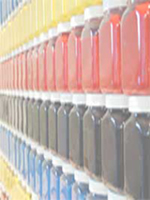Screen Printing Inks
You must match match your ink to the material/ substrate being printed or the pigments will not adhere and the ink will scratch/ rub/ fall off or fade. There are thousands of ink combinations available, however by using a professional grade ink you can print a much broader spectrum of items using the one ink - in the case of the new Aquatex Fabric inks 100% cotton through to 100% polyester without extenders or fixers.
It's important to know many inks are designed for printing a single type of item (i.e. 90% cotton: 10% nylon), so application of the ink is more important than cost - considering ink cost is normally less than a cent per print.
On this page:
Fabric Screen Printing Inks
Suitable for 100% cotton to 100% Polyester = all cotton/ poly blends
We use and recommend the new Aquatex brand, as this is the best multi purpose fabric screen printing ink available worldwide.
What makes Aquatex so good??
Generally fabric inks are designed to print either cotton or polyester (a synthetic material found in almost all garments), but not both or a mixture of either.
Aquatex is designed to print 100% cotton right through the spectrum to 100% polyester without adding extenders or fixers to the ink - so any blend can be printed instantly straight out of the bottle. One ink for all fabric applications saves you valuable money.
If Aquatex brand is unavailable you can use other brands, provided they are true water based fabric screen printing inks such as Permaset Aqua. The ink should have a neutral smell (no chemical odours) and should not crack when printed and heat set.
Fabric inks can be separated into the following groups which vary upon the pigment level, thickness and material to be printed:
 |
Standard Colours Low pigment level for printing onto white and light colours. |
 |
Process Colours Create custom PMS grades. Low pigment level for printing onto white and light colours |
|
 |
Opaque Colours |
 |
Fluorescent Colours Available in both standard and opaque colours. |
|
 |
Metallic Colours As with Opaque inks, metallic contain a high pigment level for printing black and dark colours, and also suitable for printing light colours with a thicker coat. |
 |
Puff Colours Create raised prints |
|
 |
Glow Ink Glow/ Phosphorent green ink that glows in the dark |
Ink Bases and Transparent Mixers Available in both standard and opaque colours. |
Fabric Ink Additives
Additives enhance/ extend the ink base without altering the pigmentation levels, as when adding water.
 |
Retarder - 200ml |
 |
Retarder - 500ml Trade pack size of Retarder |
|
 |
Fabric Stretch Additive - 160ml Increase elasticity of inks by up to 20%. Suitable for use on lycra and stretch materials |
 |
Fabric Stretch Additive - 5 Litre Bulk pack |
|
 |
Thickener - 40ml Thickens inks. Suitable for use when too much Retarder has been added or where thicker consistency is desired. |
Thickener - 500ml Trade pack quantity of Thickener |
||
 |
Poly Prop Additive - 182ml Creates an air cure ink when mixed with opaque fabric ink |
 |
Poly Prop Additive - 5 Litre Trade pack quantity of Poly Prop Additive |
|
 |
Copper Mix with any coloured ink to give a metallic copper tint |
 |
Metallic White Mix with any coloured ink to give a metallic tint |
|
 |
Gold Mix with any coloured ink to give a metallic gold tint |
Air Cure Inks
Suitable for polypropylene bags and polar fleece
Air cure inks are used when printing polypropylene bags, polar fleece and items not suitable for heat setting as they will melt or be damaged.
A two part mix creates the air cure ink by combining any of the Opaque Fabric Ink Colours with Poly Prop Additive.
When the Poly prop Additive and Opaque Ink are mixed, the ink will begin to dry and set with contact to air, so it's recommended you print all items in one process. If stopping, you must clean the screen or ink will dry and block the design.
Adding Fabric Ink Retarder is recommended in many instances to stop ink drying, however adding retarder will also increase the setting time of the ink by up to 5 days.
This is an intermediate to advanced technique due to the ink drying faster than normal, so normal printing of Opaque Inks should be mastered before moving to adding Poly Prop Additive, as keeping the screen clear of ink is essential or it will begin to dry and a complete screen clean is required.
Aqua Ink for Plastic and Metals
Suitable for quality Plastics, Metals, Vinyl's, CD's, etc.
Aqua Ink is a professional water based ink for use on quality plastics, metals and other surfaces not suitable for standard fabric screen printing inks.
Aqua Ink can be used with all ScreenMaster mesh grades, plus all PRINT GOCCO Print Masters.
Aqua Ink is weather resistant when dry, has a strong U.V. tolerance (not recommended for long term outside use i.e. 2 years+) and completely permanent when cured. View colour range and full ink details here . .
Ink Suitability Chart
The following is a quick guide the the general applications and uses of inks. It's important to note some inks can be used for multiple purposes where the user understand the application/ drying time etc.
![]() As always, it's recommended you test a sample of the ink to be applied to the item where the surface is unknown.
As always, it's recommended you test a sample of the ink to be applied to the item where the surface is unknown.
This applies to all:
Synthetic fabrics other than polyester i.e. nylon
Coated papers, coated metals, coated plastics and all leather
All plastics other than ABS
Ink Type |
T-shirts |
Cotton |
Polyester |
Nylon* |
Lycra** |
Polar Fleece* |
Silk |
Paper |
Wood^ |
Glass |
Ceramics |
Corflute |
ABS Plastic |
Vinyl |
Recycled Plastic |
Metal" |
Leather |
| Aquatex Fabric Ink - Standard Base |
|||||||||||||||||
| Aquatex Fabric Ink - Opaque Base |
|||||||||||||||||
| Aquatex Fabric Ink - Puff Base |
|||||||||||||||||
| Kera Underglaze Printing Ink | |||||||||||||||||
| Kera Onglaze Printing Ink | |||||||||||||||||
| FastBrigt Low Firing Ink | |||||||||||||||||
| Aqua Ink |
* Additional ink additive required for extra adhesion (Poly Prop Additive)
** Additional ink additive required for increased ink stretch (Stretch Additive).
^ If wood is coated test before use.
" Coated metal may require testing as some coatings will not be suitable for printing as the coating by nature is designed to reject ink (or any other item trying to adhere)
Plastisol and Solvent Inks
Plastisol is a general term used to describe the most common form of solvent based chemical ink, composed primarily of PVC (polyvinylchloride) resin and plasticizer. Original plastisol inks were highly solvent, nowdays they have much less solvent and are called a thermoplastic ink, as the ink is thermal and will remelt if in contact with a hot surface such as an iron - meaning garments mys be indirectly heat set or flash cured.
Whilst an old technology, Plastisol inks remailn widely used by professional printers as they offer advantages over water based rivals when used with fully automated printing equipment, however with the the development of the new generation Aquatex inks today there are often more disadvantages to using Plastisol than advantages for manual printing.
Aquatex pigments bond to the actual fibres of the material creating a permanent, soft, flexible and dry cleanable print. Plastisol inks do not dye the fibre, they bond around the outside of the fibres, sitting on top to create a film above the garment. By sitting on top or the fibres the print is easily cracked or broken when the fabric is stretched/ pulled/ rolled/ flexed as the bonds is more easily broken than that of a penetrating ink.
![]()
Page Information:
Level: Beginner to Advanced
< Previous: Supplies homepage
> Next: Standard Fabric Inks
Last modified: 16 April, 2010
